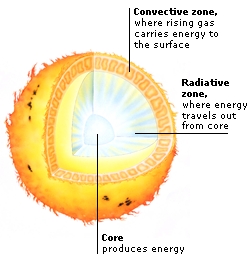DK Science: The Sun
Dominating our corner of space is a star we call the Sun. It travels through space with a family of planets, moons, and other bodies, which form the Solar System. The Sun is huge – over 100 times wider than Earth. It has the most mass of any object in the Solar System, 750 times more than all the other bodies put together. Sometimes the Moon passes in front of the Sun during the day and a SOLAR ECLIPSE occurs.
Table 8. ESSENTIAL DATA
| Diameter at equator | 1,400,000 km (865,000 miles) |
| Distance from Earth | 149,000,000 km (93,000,000 miles) |
| Mass (Earth=1) | 330,000 |
| Average density | 1.41 x water’s density |
| Rotation period | 25.4 days (at equator) |
| Surface temperature | 5,500°C (9,930°F) |
| Core temperature | 15,000,000°C (27,000,000°F) |
| Age | 4.6 billion years |
Never look directly at the Sun, especially through a telescope or binoculars. Its glare may blind you.
Layers of gas surround the Sun, forming an atmosphere. The atmosphere’s outer layer is called the corona (crown). In ultraviolet light, it is revealed to be full of loops of hot gas. These coronal loops may rise as high and as wide as 500,000 km (300,000 miles). The inner layer of the Sun’s atmosphere is a pinkish colour and is called the chromosphere (colour-sphere).
From time to time, dark patches called sunspots appear on the Sun’s surface. These regions are around 1,500°C (2,700°F) cooler than the rest of the surface. They vary in size from a few thousand kilometres up to 100,000 km (62,000 miles). Sunspots may last for a few hours or several weeks. The number of sunspots rises and falls over a period of about 11 years – this is known as the sunspot cycle.

The surface of the Sun is a seething mass of gases, like a stormy sea. One of the reasons for this is its powerful magnetic field, which can be thousands of times stronger than Earth’s. Close up, the surface appears covered in speckles, called granulations, with dark sunspots and light areas caused by explosions called solar flares.
Scientists at the Sudbury Neutrino Observatory in Ontario, Canada, use a tank deep underground to detect particles called neutrinos. Neutrinos are produced at the centre of the Sun and other stars, and by studying them astronomers can learn more about the cores of stars. Neutrinos pass through matter, such as the Earth, and are detected underground because there is less interference from other particles.
The Sun constantly emits streams of electrically charged particles known as the solar wind. The solar wind is mainly responsible for the weather conditions in space around Earth. The Sun sometimes ejects a huge blast of particles, called a coronal mass ejection. This makes the solar wind stronger and can cause magnetic storms on Earth that affect compasses and disrupt radio signals.
Sometimes, as the Moon circles around the Earth, it passes directly in front of the Sun and blocks out its light. This is known as a solar eclipse. If the Moon only partly covers the Sun, we see a partial eclipse. If it covers the Sun completely, we see a total eclipse. A total eclipse is rare – usually the Moon passes slightly above or below the line between the Sun and the Earth. When a total eclipse occurs, day turns to night and the air becomes cold. A total eclipse can last for up to 7 1/2 minutes but is usually shorter.
From Earth, observers cannot usually see the corona, or outer atmosphere of the Sun, because the photosphere (surface) is so bright. During a total eclipse, however, the moon blocks out the surface and we can see the Sun’s atmosphere. It appears as a milky halo around the Moon and extends millions of kilometres out into space. Its temperature can reach 3 million °C (5.4 million °F).
During a solar eclipse the Moon casts a shadow on the Earth. Observers see a total eclipse if they are in the umbra, the central and darkest part of the shadow. Observers in the part-shadow, or penumbra, see a partial eclipse. As the Moon orbits the Earth, the umbra traces a path across the Earth’s surface known as the path of totality (total darkness), up to 270 km (170 miles) wide.

